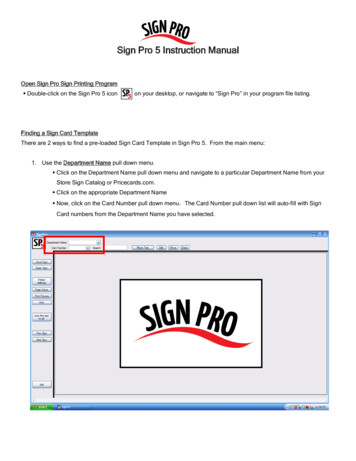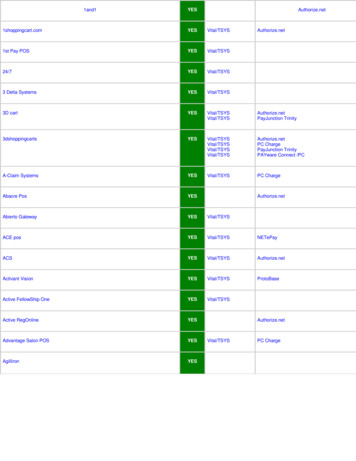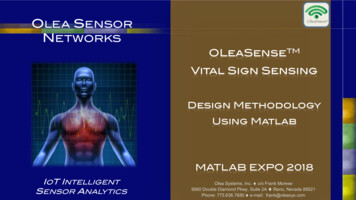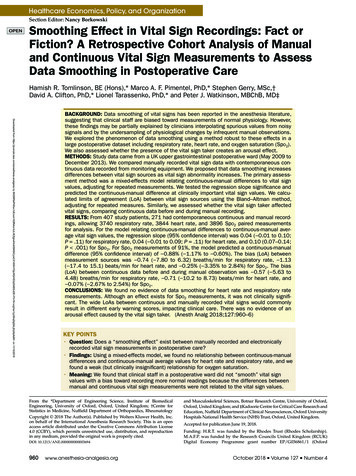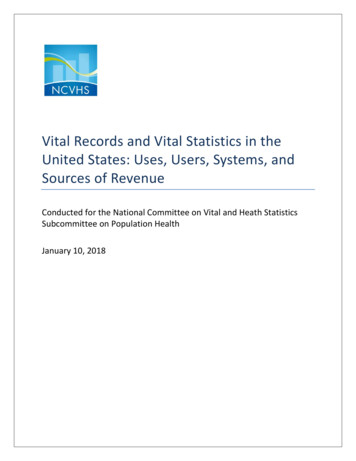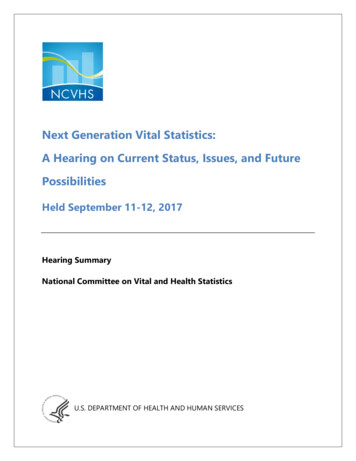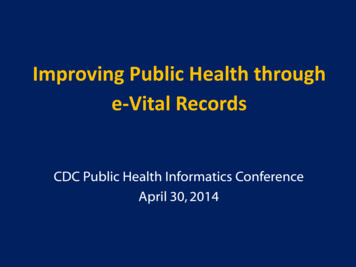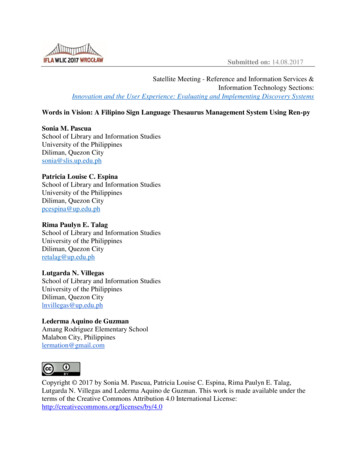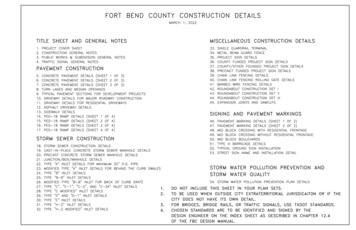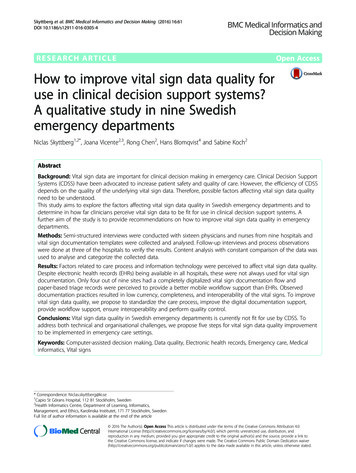
Transcription
Skyttberg et al. BMC Medical Informatics and Decision Making (2016) 16:61DOI 10.1186/s12911-016-0305-4RESEARCH ARTICLEOpen AccessHow to improve vital sign data quality foruse in clinical decision support systems?A qualitative study in nine Swedishemergency departmentsNiclas Skyttberg1,2*, Joana Vicente2,3, Rong Chen2, Hans Blomqvist4 and Sabine Koch2AbstractBackground: Vital sign data are important for clinical decision making in emergency care. Clinical Decision SupportSystems (CDSS) have been advocated to increase patient safety and quality of care. However, the efficiency of CDSSdepends on the quality of the underlying vital sign data. Therefore, possible factors affecting vital sign data qualityneed to be understood.This study aims to explore the factors affecting vital sign data quality in Swedish emergency departments and todetermine in how far clinicians perceive vital sign data to be fit for use in clinical decision support systems. Afurther aim of the study is to provide recommendations on how to improve vital sign data quality in emergencydepartments.Methods: Semi-structured interviews were conducted with sixteen physicians and nurses from nine hospitals andvital sign documentation templates were collected and analysed. Follow-up interviews and process observationswere done at three of the hospitals to verify the results. Content analysis with constant comparison of the data wasused to analyse and categorize the collected data.Results: Factors related to care process and information technology were perceived to affect vital sign data quality.Despite electronic health records (EHRs) being available in all hospitals, these were not always used for vital signdocumentation. Only four out of nine sites had a completely digitalized vital sign documentation flow andpaper-based triage records were perceived to provide a better mobile workflow support than EHRs. Observeddocumentation practices resulted in low currency, completeness, and interoperability of the vital signs. To improvevital sign data quality, we propose to standardize the care process, improve the digital documentation support,provide workflow support, ensure interoperability and perform quality control.Conclusions: Vital sign data quality in Swedish emergency departments is currently not fit for use by CDSS. Toaddress both technical and organisational challenges, we propose five steps for vital sign data quality improvementto be implemented in emergency care settings.Keywords: Computer-assisted decision making, Data quality, Electronic health records, Emergency care, Medicalinformatics, Vital signs* Correspondence: Niclas.skyttberg@ki.se1Capio St Görans Hospital, 112 81 Stockholm, Sweden2Health Informatics Centre, Department of Learning, Informatics,Management, and Ethics, Karolinska Institutet, 171 77 Stockholm, SwedenFull list of author information is available at the end of the article 2016 The Author(s). Open Access This article is distributed under the terms of the Creative Commons Attribution 4.0International License (http://creativecommons.org/licenses/by/4.0/), which permits unrestricted use, distribution, andreproduction in any medium, provided you give appropriate credit to the original author(s) and the source, provide a link tothe Creative Commons license, and indicate if changes were made. The Creative Commons Public Domain Dedication o/1.0/) applies to the data made available in this article, unless otherwise stated.
Skyttberg et al. BMC Medical Informatics and Decision Making (2016) 16:61BackgroundVital sign data are important in emergency care decisionmaking, especially for prioritization and identification ofsevere illness. To screen for sepsis, vital signs are essentialin early detection [1, 2], and it is well known that rapiddetection and early treatment are key factors to improvepatient survival [3]. Studies in the emergency departmentshow that vital signs can be used in predicting cardiacarrest [4, 5] and sepsis outcome [6]. Further, the vital signsare broadly used in clinical care in the calculation ofwarning scores that are aiming at predicting clinicaldeterioration [7, 8]. In emergency care, the first use of thevital signs is often in the triage of arriving patients [9–11].Reports show that triage systems are used in almost allSwedish emergency departments [12, 13] and that themajority of the hospitals use the rapid emergency triageand treatment system (RETTS) [10]. The commondenominator of most triage models is that they use vitalsign measurements to calculate a triage score.Clinical Decision Support Systems (CDSS) using datafrom electronic health records (EHR) are advocated toimprove clinical outcome [14, 15], quality and patientsafety [16]. In emergency care, some studies have indicated that triage CDSS may provide reliable calculationsof triage severity [17] and even improve risk assessment[18], while others have questioned the readiness forautomation [19] . To be trustworthy the CDSS need toprovide reliable advice to the clinician. The quality ofthe CDSS recommendations will depend on the quality ofthe underlying data in the EHR [20]. When comparing totraditional definitions of data quality, stating that quality isgood enough when the data can fulfil the intendedpurpose [21–23], this means that the underlying data hasto be able to support reliable calculations in the CDSS. Toprovide reliable triage scores, the vital sign data needs tobe correct, complete, and timely available. A comprehensive review by Weiskopf and Weng describes these threemain data quality categories as; Correctness, Completeness, and Currency [24], where the correctness of the dataindicates to how true the documented vital signs are,completeness refers to whether all expected vital signs areactually registered in the EHR and currency is linked tothe temporal aspects of the documented vital signs.The yearly report on healthcare IT and e-health inSweden [25] shows that EHRs have a penetration of a100 % in Swedish emergency care hospitals, and basedon this high penetration combined with the wide use oftriage systems, a high completeness of vital signs may beexpected. However, some studies indicate problems withvital sign data quality. A study by di Martino et al. showthat the completeness of the vital signs needs improvement [26], further Genes et al. [27] state that vital signdata correctness is relatively low, and finally Ward et al.[28] question the operational integrity of the timePage 2 of 12stamps after EHR implementation. Less is known aboutwhich factors affect emergency care EHR data qualityand in what way they affect it [26, 29]. The di Martino[26] study shows that a clinical improvement programmay increase completeness and Wager et al. [29] statethat the entry device will have an effect on correctnessand currency. If CDSS is expected to have an impact onpatient safety and quality, more knowledge is needed onhow to assure and improve clinical data quality. Thisknowledge can be used both to support CDSS development and in clinical quality improvement work.ObjectiveThe aim of this study is three-fold. Firstly, to explore thefactors affecting vital sign data quality during measurementand documentation in Swedish emergency care. Secondly,to determine how far clinicians perceive documented vitalsign data to be fit for use in clinical decision supportsystems. Thirdly, to provide recommendations on how toimprove vital sign data quality in emergency care.MethodsWe explored the factors affecting vital sign data qualityin emergency care using a qualitative approach. Theexplored process of vital sign collection and use isdescribed in Fig. 1. Data collection was done throughsemi-structured interviews, observations and analysis ofdocumentation templates in nine purposefully selectedSwedish emergency departments. We used contentanalysis with constant comparison to categorize thedata [30–32].The study was performed during a period of tenmonths (August 2014 – May 2015).Setting and participantsInclusion criteria for the participants were a degree asMedical Doctor (MD) or Registered Nurse (RN) with aminimum of five years of experience in emergency care,in particular, triage and vital sign documentation.Quality managers at the sites were contacted and helpedto identify a total of sixteen participants that fulfilled theinclusion criteria. The participants were invited by emailand all accepted to participate in the study.Sites were included aiming at variability in size andregional distribution. In total, nine hospitals (Table 1)were included in the study, five university hospitals(UH) and four secondary referral centres (SRC). Threedifferent Electronic Health Record Systems were used atthese sites.Data collectionData was collected in three subsequent steps. First,sixteen semi-structured interviews were conducted atnine different sites (Table 1). The interviews were
Skyttberg et al. BMC Medical Informatics and Decision Making (2016) 16:61Patientarrival atemergencycareTriageVital signmeasurementCalculation ofTriage ScoreDocumentationof vital signsPage 3 of 12InvestigationandTreatmentReevaluation ofvital signsPatientleavingemergencycareCalculation ofwarning scoresDocumentationof vital signsFig. 1 Emergency care process. Vital sign measurement and documentation in the emergency care processperformed using a semi-structured interview guide(included in the Additional file 1) covering different aspects of data quality such as completeness, correctness,and currency. The interview guide also aimed to coverhow the participants experienced existing vital sign dataquality and perceived opportunities to increase vital signdata quality in the EHRs. The guide was tested in a pilotinterview. All interviews were voice recorded, performedin Swedish, either on-site or by telephone, and lasted forabout 30 min.Confirmation was sought with the participants toverify the findings from the interviews. This was donethrough second round interviews with open-endeddiscussions on the themes and categories found in theresults. The participants were selected as they representeddifferent documentation practices in the initial interviews.The interviews were performed on site in Swedish, lastedfor about 45 min each and were voice recorded.After the interviews, observations were performed atthree selected sites aiming to complement the datacollected during the interviews. Sites No. 2, 4 and 8 werepurposefully selected for the observations as they represented examples of three different documentation practices that were found in the initial interviews (Table 3).Observations focused on vital sign measurements anddocumentation in the emergency departments, aimingTable 1 An overview of the performed interviewsSiteNumberTypeED Visits#MDs Interviewed#RNs InterviewedSite 1UH6500011Site 2SRC40000Site 3SRC30000Site 4UH970002Site 5UH530001Site 6SRC800001Site 7SRC390003Site 8UH450002Site 9UH53000131to cover a variation in locations, staff, and clinical situations. The observations aimed to confirm the findingsfrom the interviews in clinical practice and they lastedabout 60 min per site. The observations were performedby the researchers together with a nurse from the site.The observers were free to move around the emergencydepartment during the observations and during theobservations photos and field notes were taken andsamples of documentation templates were collectedfrom the emergency departments. From the observations, a structured report was written. The observationreport protocol is included in the Additional file 1.Two researchers (NS and JV) performed the interviewsand observations. A third and fourth researcher (SK andRC) continuously gave feedback on interviews and results.Data analysisThe recorded interviews were transcribed and coding wasdone by reading through the transcripts. Quotes andmeaning units were translated into English. The codeswere inductively abstracted into categories and themes.Transcription, coding, abstraction and rechecks withthe audio recordings were done continuously. Two researchers (NS and JV) performed coding and abstractionseparately. Discussions in the research group were heldto compare coding and emerging categories, makingconcepts and categories change and evolve during theprocess. Changes in the coding and categories diminished over time and eventually a consensus on categorieswas reached in the research group. Interviews wereperformed until no new concepts or categories emerged.After consensus and saturation, the results from the analysis were confirmed by three of the initial participantsin the form of open second-round interviews. These interviews were transcribed and coded in the same way asthe first-round interviews. Additional data such asdocumentation templates and field notes from theobservations were subsequently included in the analysis.This further confirmed saturation and strengthened ourconfidence in the interpretation of the initial interviews.
Skyttberg et al. BMC Medical Informatics and Decision Making (2016) 16:61Ethical considerationsEthical approval was applied for at the StockholmEthical Committee but not considered to be needed(Dnr 2014/1207-31/4). Information on the study wasgiven in advance and informed consent was obtained.Participation was voluntary and confidentiality wasassured. To assure confidentiality none of the quotes areconnected to the sites in the publication.ResultsFactors affecting vital sign data qualityThe factors resulting from the content analysis are presented according to the main themes and categories thatwere found in our analysis (Table 2). The table includesexamples of subcategories, meaning units and corresponding quotes. The quotes are related to the type ofdocumentation practice found at the site; paper-baseddocumentation, mixed documentation, and digitaldocumentation (Table 3).Care processA standardized process The interviews showed aperceived importance in following a predefined workflowto increase the quality of vital sign data measurementand documentation. Without a standardized process,individual staff considerations guided decisions aboutwhen and how to measure and document vital signs.Hence, a standardized process was perceived to increasequality by reducing individual variations.The results showed that most patients were expectedto be triaged early after arrival at the emergency department. “We do triage all patients arriving at the emergency department. No difference if they are arriving byambulance or walking in. A short history and measurement of the vital signs are expected in all patients.”(digital documentation). All but one site used the rapidemergency triage and treatment system (RETTS) as thetriage system and usually, triage was expected to becompleted within 15 min of arrival. However, at two ofthe sites triage was only performed if there was a waiting time to see the doctor. If there was no waitingtime, vital signs were measured at the physicians’ initiative or order only.Switching to a standardised workflow, where allpatients were expected to be triaged, was mentioned toimprove the measurements and documentation of vitalsigns. As discussed on the example of respiratory rate inone interview; “I think it has improved a lot (dataquality of vital sign). Before the structured workflow wasset, respiratory rate was not completed as often as today”(digital documentation).Repeated measurements of vital signs were mentionedas an area with poor data quality. This was attributed tothe lack of a standardized process “There are difficultiesPage 4 of 12in finding a routine both in measurement and documentation (in the re-evaluation of vital signs)” (digital documentation). One interpretation of the difference betweentriage and repeated measurements is that the start of theemergency care process is easier to standardize. Thelater part of the process may be more diverging anddepending on the patient's complaints (see also Fig. 1).One of the sites mentioned having implemented vitalsign rounds at the emergency department. Patients withhigh triage scores were expected to have their vital signsrechecked every 15 to 30 min. The aim was to avoidunnoticed patient deterioration by standardizing reevaluation of the vital signs.Even with a set standard in place not all staff acceptand follow the routine; “If the patient has a minorcomplaint the standard may not always be experiencedas relevant. In those cases, there may be a failure tocomply” (paper-based-documentation). Individual decisions were described to affect the vital sign data as wellas the quality of the care given. In one of the interviews,this type of individually based triage was described “themost dangerous of triage practices” (digital documentation). However, some of the interviews mentioned thatthis practice may be more common among experiencedstaff. If a conscious decision to diverge from the standard was made by experienced staff members, this wasperceived as having less impact on the quality of care.The effect on the vital sign data quality would be thesame regardless of staff experience.A well-defined workflow was experienced to increasethe number of complete vital sign measurements. Thetriage process was an example used in all interviews.However, to be fit for use in CDSS the vital signs alsohad to be registered in the EHR, as is further discussedunder documentation support.Management Management factors were found toimpact the data quality of the vital signs. Opportunitiesfor a quality increase were seen by controlling thequality and giving feedback on performance, but also byleading the organization through resistance to change.When discussing quality management both local andgovernment control were mentioned as important. "Wehave done manual record reviews to check the documentation of vital signs. We do regular sample checks of vitalsign registrations and give feedback to the staff" (mixeddocumentation). "We received feedback from theNational Board of Health and Welfare considering ourdocumentation of vital signs. That has made us changeour routines on documentation and the way we follow upcompliance to the documentation standards" (digitaldocumentation). The observations supported that feedback on quality was given, for example, quality indicators were found posted on boards in staff areas.
Skyttberg et al. BMC Medical Informatics and Decision Making (2016) 16:61Page 5 of 12Table 2 Factors affecting vital sign data qualityThemes, categories and example quotesThemeMain categorySubcategoryCare processStandardizedprocessStandardized triage Standardized Triage - Securing Vital Signmeasurements“We do triage on all patients arriving at theemergency department. No difference if theyare arriving by ambulance or walking in. A shorthistory and vital sign measurements areincluded in all patients.” PDStandardizeddocumentationStandard of documentation improvescompleteness“I think it has improved a lot (data quality ofvital sign). Before the structured workflow wasset, respiratory rate was not completed as oftenas today." DDFailure to complyFailure to comply - Individual ClinicalJudgement“If a patient has a minor complaint the standardmay not be experienced as relevant. In thosecases, there may be failure to comply” DDLack of standardLack of Standard in repeatedmeasurement documentation“A patient was kept close to the nurse deskwith automated continuous vital signmeasurements for hours. Only two recordingswere entered into the EHR.” DDQuality controlGovernment Control of Care Quality“We received feedback from the National Boardof Health and Welfare considering ourdocumentation of vital signs. That has made uschange routines on documentation and theway we follow up on compliance withdocumentation standards” DDChangemanagementResistance to change - switching todigitalized flow[switch to digitalized flow] “It wasn t completelyeasy to achieve. At first, the physicians lackedthe paper. But nowadays no one wants toswitch back.” DDEducation/trainingof staffUnderstanding of documentationimportance“You have to educate to increase theunderstanding why it [documentation] isimportant. Otherwise, there may be neglect ofregistrations.” MDMethod andequipmentError sources - temperature, ear wax“When it comes to temperature measurementsthere may be problems due to simple errorsources, like wax in the ear canal.” MDClinicalcompetenceClinical Validity check“You cannot always trust the device. You haveto make a clinical validity check. If there is aproblem, you may have to recheck or changemethod.” DDMobile documentation required whenswitching to digitalized flow“Unless we get access to computers at everyroom or more mobile ways of working, likeiPADs we will likely hold on to the paper triagerecord” PDOverviewsOverview of vital sign measurements“We need a good overview of measurements sothat they can be followed over time.” PDChecklistsProcess overview and checklist.“What we lack in the EHR is a usable alternativeto paper-based triage record. It should provideoverviews and checklists to make sure thateverything that should be done gets done andthat nothing is forgotten” PDManagementCompetence andknowledgeInformationtechnologyWorkflow support MobilityDocumentationsupportMeaning unit (examples)Quote and type of documentation practiceCalculation support Automatic calculation of triage score“We enter the short history and vital signs inthe EHR and with a click, the triage colour willbe calculated.” DDStructureddocumentationDocumentation templates - anxietyabout forgetting“It makes sure that everything gets done andthat we all do it the same way. It will decreaseanxiety about forgetting. “PDLogical controlsLogical controls - dictation and free text“We use dictation to enter the vital signs intothe EHR. It will be entered in free text. There areno built-in logical controls.” MD
Skyttberg et al. BMC Medical Informatics and Decision Making (2016) 16:61Page 6 of 12Table 2 Factors affecting vital sign data quality (Continued)Interoperability“To complete the triage all vital signs have tobe registered. It is a part of the triage processand the system demands a full set.” DDCompletenesschecksCompleteness checksAutomaticregistrationsAutomatic registrations of measurements “Automatic registration of repeatedto improve completenessmeasurements would really improvedocumentation. If patients are measured every15 min, there is no time to manually register allmeasurements.” DDInteroperabilitywithin systemReuse of information between modulesin EHR“We are working in our acute care module. Wedon’t want to use separate parts of the systemmaking double entries" DDInteroperabilitybetween systemSharing information with pre-hospitalrecords“Vital signs will be measured in the ambulance.We will manually copy them into our EHR." DDFootnote: In the table the following abbreviations are used in relation to the quotes; Paper-based documentation (PD), Mixed documentation (MD) and Digitaldocumentation (DD)Analysed documents showed that feedback focused oncomparing results of the measured indicators to setgoals.Change management referred to resistance to changein an organization. "No, we don t have any data ontriage vital signs in the EHR as we keep that record onpaper. It is tradition and routine and we are quite stuckwith it." (paper-based documentation). At some of thesites such resistance had been overcome "It wasn t completely easy to achieve (switch to electronic documentation), but nowadays no one would consider moving backto paper" (digital documentation). These sites stressedthe importance of leadership and management in making the change happen.Competence and knowledge Understanding the medical equipment, measurement methods and being able tocritically evaluate the results was perceived to impactthe correctness of the documented vital signs. “Considering temperature measurements there may be problemsdue to simple error sources, like wax in the ear” (mixeddocumentation). If the limits and error sources were notunderstood and known this was perceived as leading toincorrect registrations of vital signs.The importance of clinical competence when evaluating the plausibility of vital signs and the knowledge oferror sources in measurement methods were mentionedas related to data quality. This was discussed in relationTable 3 Documentation practiceDocumentationpracticeDescriptionNumberof sitesPaper-baseddocumentationDocumentation on a structured paper-based 2 Sitestemplate and later scanned into the EHR inpdf format. No entries of vital signs weredone in the EHR.MixedDocumentationDone on a paper-based template and later 3 sitestransferred into a digital EHR template.DigitaldocumentationDocumentation on a digital template4 sitesto the correctness of the registered vital signs. “You cannot always trust the device. You have to make a clinicalvalidity check. If there is a problem, you may have to recheck or change method.” (digital documentation). Thecompetence and knowledge factors were experienced tobe managed by training of the junior staff and by the support given by more experienced colleagues.Information technologyDocumentation support The interviews showed thatthree different documentation practices were in place atthe sites (Table 3), and only four of the sites did use afully digitalised documentation flow of vital signs. Allsites had implemented EHRs but these were notperceived as supporting documentation in a mobile fastpaced emergency care context where staff and patientswere described as mobile but IT systems were experienced to be stationary and not always available to thestaff at the point of care. Paper-based records weredescribed as light-weight, portable and easy to use whenrecording vital signs. “We use the paper record as an emergency record, we register all vital sign measurements andby that way, they are close at hand without any need tolog in to the computer” (paper-based documentation).When paper-based templates were used and transferredto the EHR the currency of the data might be affected.Even if time stamps were reported to be manually set inthe EHR to represent measurement time, this practice wasdescribed as inconsistent among staff especially when theworkload was high.Retrospective documentation was also perceived toaffect the willingness to reenter data into the EHR. “Itfeels like double documentation and double work totransfer the paper documentation into the electronichealth record.” (paper-based documentation). Whentransferring data to the EHR not all measurements wereexpected to be registered. At sites where documentationwas fully digitalized, according to the interviews, thestaff was observed using paper notes to record the values
Skyttberg et al. BMC Medical Informatics and Decision Making (2016) 16:61in order to enter them into the computerized recordlater on. This observational finding contrasted findingsin the interviews, where all the documentation workflowwas described as done in the EHR.The use of specific documentation templates for theemergency care process was expected to support correctand complete registrations but none of the sites was observed to provide completeness checks with remindersor other intrusive ways to force completeness of vitalsign documentation. The EHRs were observed to giveplausibility warnings on values that were out of biologicalrange but for these warnings to work standardizedtemplates had to be used. Automation of documentation was mentioned in the interviews as a possibleway of affecting completeness and currency. “Automatic registration of repeated measurements wouldreally improve documentation. If patients are measured every 15 min, there is no time to manuallyregister all measurements.” (mixed documentation).No sites had any information exchange in placebetween of measurement devices and the EHR.The documentation support was discussed under allaspects of data quality, and mobility and ease of usewere found important to support timely and completeregistrations of the vital signs. The use of documentationtemplates for the emergency care process connected thedocumentation support category to the workflow support and interoperability categories.Workflow support Entering vital signs into the EHRswas not perceived to support the care process but ratherlinked with later reuse of information. “The documentation (in the EHR) may be important as a reference laterat the ward” (mixed documentation). “In my work at theemergency department the documentation (in the EHR)is not important for the acute care process I rely onthe paper-based triage record" (mixed documentation).This lack of workflow support was experienced todecrease timely and complete registrations. Whendiscussing expectations on a support that would increase the quality of the registered vital signs, threesub-categories were mentioned. These were overviewsof information, reuse of information and mobility inthe workflow.Overviews of information were perceived as importantfor workflow support. Such overviews included read andwrite functionality combined with a checklist to supportcomplete registrations of the vital signs. “(in the EHR)we lack usable functionality that is there in the paper triage record. It provides an overview and a checklist of important information and makes us remember things thatare supposed to be done.” (paper-based documentation).If the information entered in the EHR was reused in theprocess at the emergency department willingness toPage 7 of 12enter information was expected to increase. Examplesgiven of such reuse included automatic calculation oftriage or warnings scores.A perceived lack of workflow support in the EHRswas discussed in many of the interviews, but thestatements were conflicting, and both at sites usingpaper and digital documentation there were participants acknowledging good-enough workflow supportin the present EHRs. These participants further statedthat management was the key factor
Background: Vital sign data are important for clinical decision making in emergency care. Clinical Decision Support Systems (CDSS) have been advocated to increase patient safety and quality of care. However, the efficiency of CDSS depends on the quality of the underlying vital sign data. Therefore, possible factors affecting vital sign data quality
